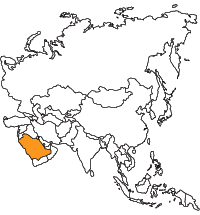Protected Areas in Saudi Arabia
NCWCD and its Mandate
The NCWCD was established by a Royal Decree in 1986. Among other things, the Decree requires the Commission to "Develop and implement plans to preserve wildlife in its natural ecology and to propose the establishment of proper protected areas and reserves for wildlife in the Kingdom, and to manage such areas...".
In accordance with this mandate, the Commission strives to protect, conserve, and develop the wildlife resources in terms of the laws of Saudi Arabia, and the welfare of its people.
Protected Areas
Considering the size of the Kingdom and its biophysical diversity, creating a comprehensive system of protected areas is a formidable task, especially as the system must be appropriate to the social, economic, and cultural characteristics of the Kingdom. The inspired determination of the Commission to conserve and develop the renewable resources of the Kingdom for the sake of all its citizens, has received international acclaim.
Islamic teachings affirm the need to conserve areas for purposes pertaining to the common good. These areas are called hima, which means "protected area" or "reserve". Some traditional himas in Saudi Arabia have been managed sustainably since early Islamic times, and are among the most long-standing examples of rangeland and woodlands conservation known. Within them resource uses such as grazing, woodcutting and hunting have been regulated or excluded in accordance with the long term needs of society, which may range from honey production to woodland conservation to forage reserves for times of drought.
Criteria for the selection of Protected Area
For the selection of sites as protected areas, the Commission has used a number of ecological and socio-economic criteria. These include:
- representative coverage of all the Kingdom's biotopes;
- protection of existing populations of key wildlife species;
- protection of habitats of key biological importance;
- the potential of the site to provide tangible economic benefits to the local people;
- sites which are of greatest value for environmental education and awareness;
- recognition of traditional protection by local people;
- an equitable geopolitical spread of protected areas.
At present the Commission manages 15 protected areas, which have been ratified by its Board of Directors. The Commission's protected areas system plan has recommended over a hundred sites for protection, constitution over 8% of Kingdom. This figure will increase to over 10% as new areas are identified and incorporated into the protected areas system.
Source: National Commission for Wildlife Conservation and Development
|


